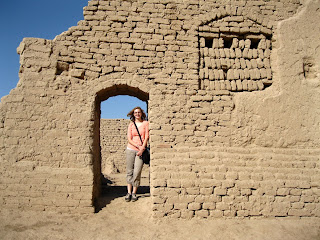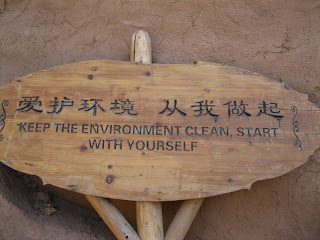Mosques. Forts. Monasteries. We saw them all! In traveling with a tour group, there are times when you think, "I'm tired! I'm just going to sit on the bus and pass this one by (and maybe read a book)." But then that little voice inside starts saying "but this might be REALLY cool, and you'll miss the only opportunity to see it." So, we saw everything. And were exhausted by the time we returned home at the end of the week.
One delightful place I almost missed was the underground water museum that showed how ancient people began digging series of wells connected by tunnels to bring water to small areas of the desert to grow crops and live on. Part of it reminded me strongly of the San Antonio river walk--except here the water is a small brook instead of a river.
As we drove through a small village, I could not believe the low standard of living. I'm sure there is no plumbing in these huts. And since it rains so seldom many of the roofs were just twigs and branches laced together. Rainstorms are categorized by the number of drops counted on the ground, i.e, "that was a 15-drop rain". Occasionally, we saw TV satellites on these huts!
I think a highlight of our trip was riding camels. We thought it would just be one of those "photo op" experiences, where you sit on a camel and have your picture taken. Nope! This was the real deal--an hour ride through dunes to a hidden oasis. With 53 of us in the group, we went in groups of 5,
but some groups are faster, or slower, than others and soon a long line was caravaning along. It was a beautiful day, about 72 degrees with a light, playful breeze.
Our jackets still felt good. I can say I would not have wanted to experience the area in the 100+ temperatures of summer, nor with a real wind blowing. The sand was very fine and would definitely have been unpleasant if it were filling the air. (On the next picture, notice all the trees of the cultivated area in the background. The government has been planting trees for the past 30-40 years, in an effort to keep the dunes out of the city of Dunhuang. You walk through sand and then cross into cool trees! It's almost weird.)
The ride was actually quite comfortable. The saddle fit in-between the twin humps of the Bactrian camel, with a metal rod to hold onto when the camel was getting up or kneeling down (for mounting or dismounting). That part was a bit crazy as the camel lurches to his feet! Otherwise, the ride was a bit more rocking than a horse, but fun. The camels were tied to one another, so there was no individual control. However, a pair of women in one group TWICE experienced a run-away. Somehow, one camel became detached from the one in front and off he went, searching for some growing scrub brush to snack on--and he led the camel behind him off on his adventure. The two women were a little anxious at first, but then laughing as their experience turned from scary to gastronomic.
The end of the ride was at an oasis, Hidden Crescent Moon (as the little lake looks like a crescent). There's a nice pagoda there (and souvenirs, of course). And Alice fell in love with camels. (Now that's a surprise!) The rest of the trip she agonized over buying a stuffed camel to take home. Fortunately, most were not really stuffed (and cuddly), they were styrofoam covered with hair. Definitely NOT cuddly. And most had weird-looking faces. Not something you'd want staring at you in the twilight of your bedroom.
But then we found the ONE! Cute face. Cuddly. At the airport, of all places! And it was a reasonable price. So we took a picture, made a memory, and left it there. After all, who wants to carry that around the rest of the week?
We flew from Dunhuang to Xi'an (where the terra cotta warriors are), which is the eastern end of the silk road--where the kings lived who sent silk westward to buy better horses to try to keep the Mongols out. It seems that their horses were bigger and faster than the Chinese ponies, so the emperor sent for some Arabians and others, trading silk and spices for them.
I enjoyed watching the desert from the air. First the dunes, then barren, rugged mountains. I was SO surprised to begin to see snow on the mountain tops, and then GLACIERS! Ones that were actually moving down the mountain and joining with others flows. But what happens to the water that melts in the spring? There was NO vegetation nearby. Apparently the water flows away, or sinks into the ground, or evaporates.
Who would have thought we'd be able to visit Xi'an a second time this year? We saw trees with leaves turning color that were just beginning to leaf out when we were there in April. And we had a good time.
We did get to spend some time on the inner-city wall. It is wide enough for cars to drive on, but as they don't do stairs very well, there is plenty of room for walking, or if we'd had more time, renting bikes and riding. The air was extremely hazy, which was a surprise for this area is usually quite clean.
It was all explained as we drove out to visit the terra cotta site, and farmers were harvesting their corn fields and burning the corn stalks. Plumes of thick, gray smoke rose from plot after plot. And made it so visibility was less than a mile.
What a great week it was, spending time with my sister, seeing things I never suspected were part of China. But after 6 days on the road, we were ready to go home to our comfortable beds and familiar surroundings. Some of the hotels had beds so hard, the carpet on the floor would have been softer but as it was sketchy looking and not clean, that wasn't really an option. We'd had 3 flights, 3 different buses, taxis, a train, donkey cart and camel ride. Yup, it was time to return to normal life.



















































